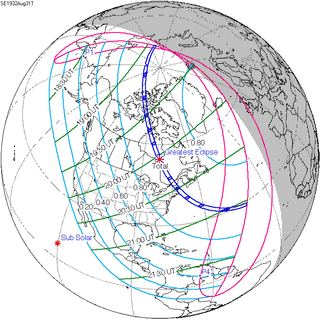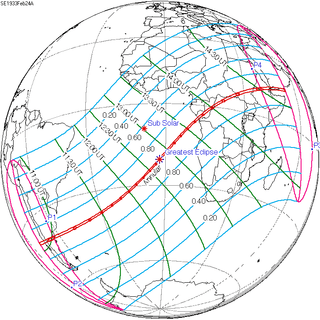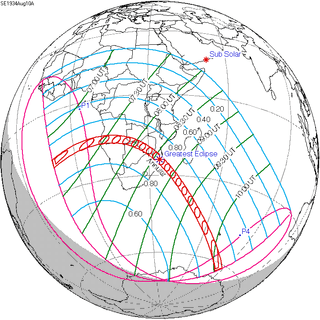Solar eclipse of August 31, 1932
| Solar eclipse of August 31, 1932 | |
|---|---|
 Map | |
| Type of eclipse | |
| Nature | Total |
| Gamma | 0.8307 |
| Magnitude | 1.0257 |
| Maximum eclipse | |
| Duration | 105 sec (1 m 45 s) |
| Coordinates | 54°30′N 79°30′W / 54.5°N 79.5°W |
| Max. width of band | 155 km (96 mi) |
| Times (UTC) | |
| Greatest eclipse | 20:03:41 |
| References | |
| Saros | 124 (50 of 73) |
| Catalog # (SE5000) | 9357 |
A total solar eclipse occurred on August 31, 1932. A solar eclipse occurs when the Moon passes between Earth and the Sun, thereby totally or partly obscuring the image of the Sun for a viewer on Earth. A total solar eclipse occurs when the Moon's apparent diameter is larger than the Sun's, blocking all direct sunlight, turning day into darkness. Totality occurs in a narrow path across Earth's surface, with the partial solar eclipse visible over a surrounding region thousands of kilometres wide.
Related eclipses
Solar eclipses 1931-1935
Each member in a semester series of solar eclipses repeats approximately every 177 days and 4 hours (a semester) at alternating nodes of the Moon's orbit.
| Descending node | Ascending node | |||
|---|---|---|---|---|
| 114 | September 12, 1931 Partial |
119 | March 7, 1932 Annular | |
| 124 | August 31, 1932 Total |
129 | February 24, 1933 Annular | |
| 134 | August 21, 1933 Annular |
139 | February 14, 1934 Total | |
| 144 | August 10, 1934 Annular |
149 | February 3, 1935 Partial | |
| 154 | July 30, 1935 Partial | |||
Notes
References
- Earth visibility chart and eclipse statistics Eclipse Predictions by Fred Espenak, NASA/GSFC
| Wikimedia Commons has media related to Solar eclipse of 1932 August 31. |

